For more information contact Robin W. Baird at rwbaird (at) cascadiaresearch.org or see our Hawai‘i odontocete research page
We will update this page every few days during the field project, with the most recent updates at the bottom of the page.
From December 1-16, 2008 we will be undertaking research in Hawai‘i, based off the island of Hawai‘i (the “Big Island”). This trip is being funded by the Southwest Fisheries Science Center of NOAA Fisheries (with the support of the U.S. Navy, N45) and Scripps Institution of Oceanography. The research team includes Greg Schorr and Robin Baird of Cascadia, Dan McSweeney of the Wild Whale Research Foundation, Daniel Webster of Bridger Consulting, Russ Andrews of the University of Alaska Fairbanks, and a number of volunteers. Our primary goals for this project are to examine movement patterns Cuvier’s and Blainville’s beaked whales (through the deployment of satellite tags) and to recover the High-frequency Acoustic Recording Package (HARP) we deployed in July, download the data and re-deploy it, to continue acoustic monitoring for cetaceans off the west coast of the island.
We have a number of additional goals:
- To examine diving behavior and acoustics of a number of species, using suction-cup attached time-depth recorders.
- Collection of blubber samples from biopsies of false killer whales and short-finned pilot whales, for a collaborative study on persistent organic pollutants of these species, with the Northwest Fisheries Science Center.
- To examine movements of melon-headed whales and false killer whales through the deployment of satellite tags, with support from Northwest Fisheries Science Center and Dolphin Quest.
- Collection of skin/blubber samples from biopsies and from suction-cups for examination of stock structure (in collaboration with Susan Chivers and Karen Martien of the Southwest Fisheries Science Center, and Sarah Courbis of Portland State University) and trophic ecology (in collaboration with Jason Turner of the University of Hawai‘i, Hilo)
- Collection of fecal samples to examine diet (a collaborative project with Mike Ford of the Northwest Fisheries Science Center, Seattle)
- Photo-identification of 10 species of odontocetes to examine residency/movements
- Collection of survey and sighting data for examination of habitat use
- Collecting dead cephalopods for trophic ecology studies
December 1, 2008 update

Spotted dolphin leaping December 1, 2008. Photo by Greg Schorr.
Our first day on the water. While the species diversity today was low (just pantropical spotted dolphins), we were able to collect one biopsy sample for genetic studies and also collected a squid (found dead floating at the surface, to go to the National Marine Mammal Lab for identification.
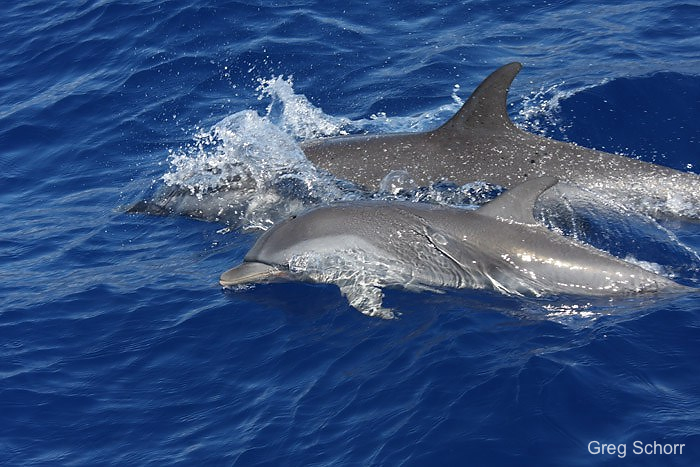
Spotted dolphin mother and calf, December 1, 2008. Photo by Greg Schorr.
December 2, 2008 update
A good second day on the water. As we left Honokohau Harbor we observed a group of spinner dolphins, a species that is often found in the area. We usually spend little time with spinners – this are our lowest-priority species, as numerous studies have been undertaken with spinner dolphins in Hawaiian waters over the last 30+ years and our time is better spent working with less frequently encountered species. Later in the morning we encountered a large group of pantropical spotted dolphins and collected another genetic sample, and later found another squid floating at the surface (this one being scavenged by two wedge-tailed shearwaters).
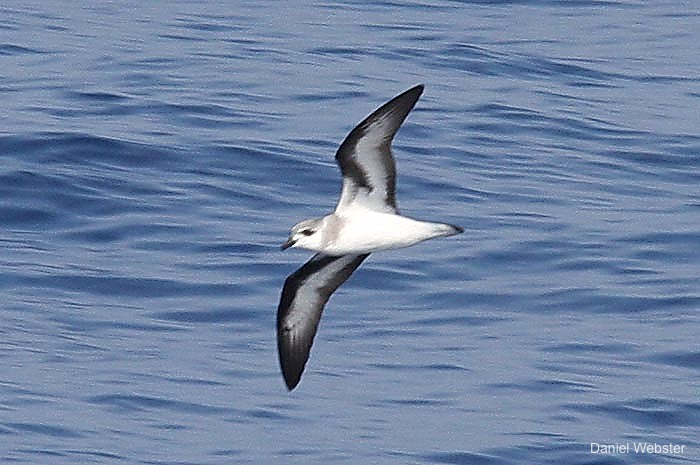
We’ve also had some good seabird sightings the last two days – yesterday a phalarope and a Hawaiian petrel, today a Hawaiian petrel and several smaller petrels, including a black-winged petrel. Photo by Daniel Webster.
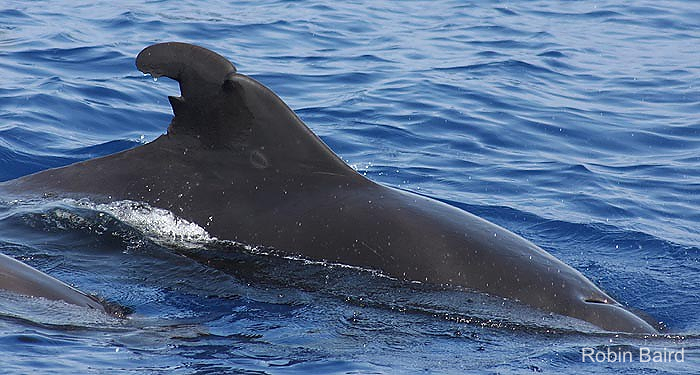
A very well-marked adult female short-finned pilot whale off Kona, December 2, 2008. Photo by Robin Baird.
We also encountered a large group of short-finned pilot whales, and collected skin/blubber biopsies from an adult female and her approximately 2-year old calf, for analyses of persistent organic pollutants. The highlight of the day was a sighting of a lone adult male Cuvier’s beaked whale. This individual was first seen taillobbing about a kilometer away, and we were able to keep track of this individual over three surfacing series (separated by 22, 21 and 14 minutes). We deployed a satellite tag on this individual (the fourth Cuvier’s we’ve tagged in Hawai‘i), and are awaiting hits from the satellite.
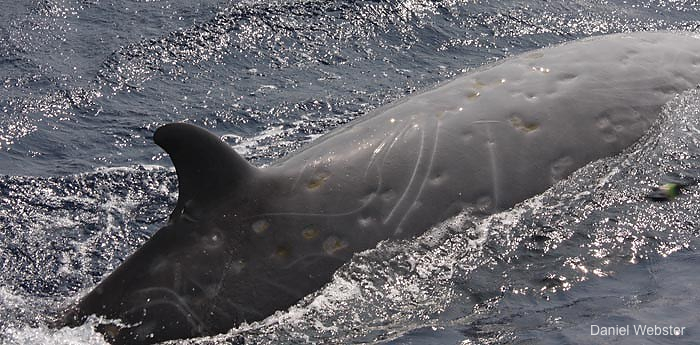
Adult male Cuvier’s beaked whale off Kona, December 2, 2008. Photo by Daniel Webster. Sabre Mahaffy was able to match photos to our catalog of this species. We’ve seen this individual, HIZc044 in the catalog, on two previous occasions, in November 2006 and in May 2008. The linear scars on this individual are caused by fights with other male Cuvier’s beaked whales (only the males have erupted teeth), while the numerous oval scars/indentations are caused by cookie-cutter sharks.
December 3, 2008 update
Another good day on the water, with an encounter with ~20 bottlenose dolphins, a group of four dwarf sperm whales, and a sighting of a black-footed albatross. Photos to follow soon.
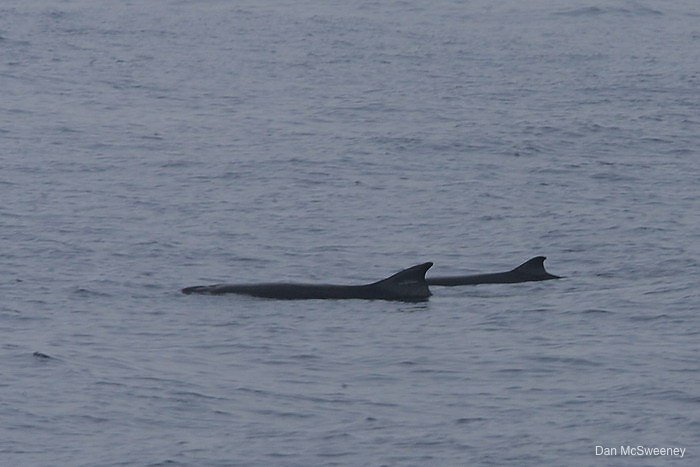
An adult female dwarf sperm whale with calf logging at the surface, December 3, 2008. Photo by Dan McSweeney. These two were part of a group of four dwarf sperm whales observed and followed for 30 minutes. When calves are present dwarf sperm whales typically dive for 7 to 8 minutes at a time, so we were able to re-sight these individuals for a number of surfacings, where they typically just log motionless at the surface. We were able to obtain photos of all four individuals, two of which were quite distinctive. A quick comparison to our photo-identification catalog for this species revealed no matches, although we do have a high re-sighting rate for this species off Kona, indicating a small population size of resident animals.
December 4, 2008 update
Although our surveys are focused on whales and dolphins we frequently observe relatively uncommon species of seabirds, and record all seabird sightings to pass on to the Hawai’i birding community. Although the numbers of birds seen in the last four days have been low, the diversity has been high.
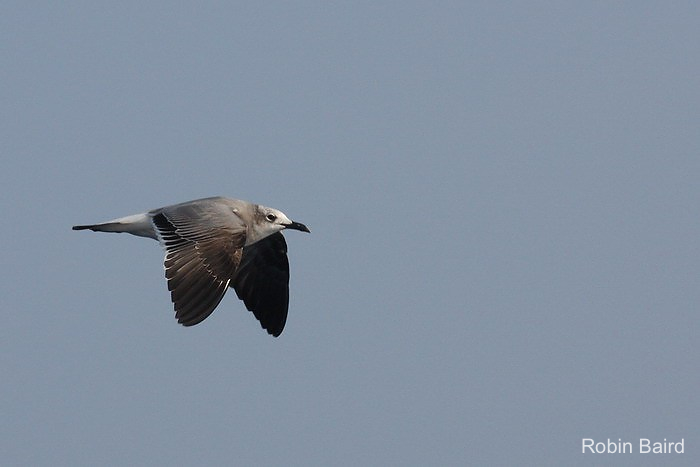
A laughing gull off Kona, December 4. Photo by Robin Baird. Gulls are uncommon around the Hawaiian Islands. Laughing gulls, like this first winter bird, are one of the gull species most frequently seen around the Hawaiian Islands.
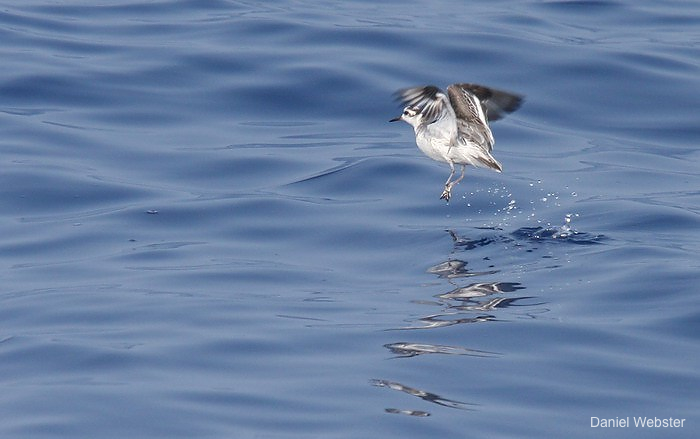
Despite the gray plumage, this is a red phalarope (in Europe they are called “grey phalaropes”). Photo by Daniel Webster. These shorebirds breed on the arctic tundra and spend the winter at sea. Adults in breeding plumage do have red plumage, but birds in non-breeding plumage, like this one, are much duller.

A leaping rough-toothed dolphin, December 4, 2008. Photo by Robin Baird. Note the large number of remoras (nine visible) on this dolphin. This dolphin was leaping repeatedly, presumably to try to remove the remoras.
December 6, 2008 update
Sighting rates this trip have been a bit lower our long-term average. In six days we’ve had only 16 sightings, but those have been of nine different species of odontocetes. On December 6 we had two new species for the trip, a dispersed group of sperm whales, and a group of pygmy killer whales.
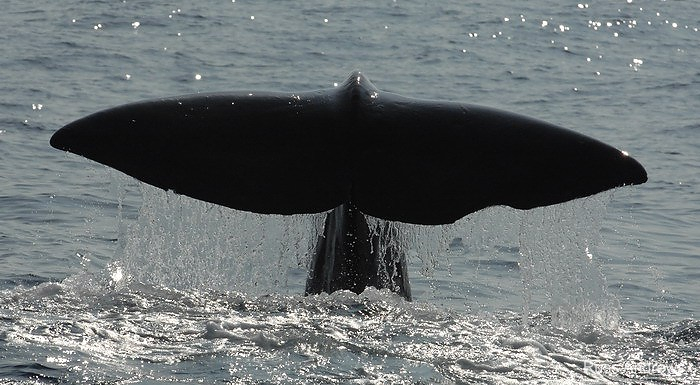
A sperm whale fluking off Kona, December 6, 2008. Photo by Russ Andrews. This group of sperm whales was found in deep water (>3,000 m) far (21 km) offshore. We observed six individuals (adult females and sub-adults) spread out over several kilometers, but it is possible more individuals in the area. We were able to obtain good identification photos of two individuals (the undersides of the tailflukes) and skin samples from both – sloughed skin found in the water after their dives. Sperm whales are not common around the main Hawaiian Islands, in our efforts over nine years (450 days on the water) we’ve only seen this species on 25 occasions. Photos from this encounter will be contributed to a photo-identification catalog for this species at the Southwest Fisheries Science Center.
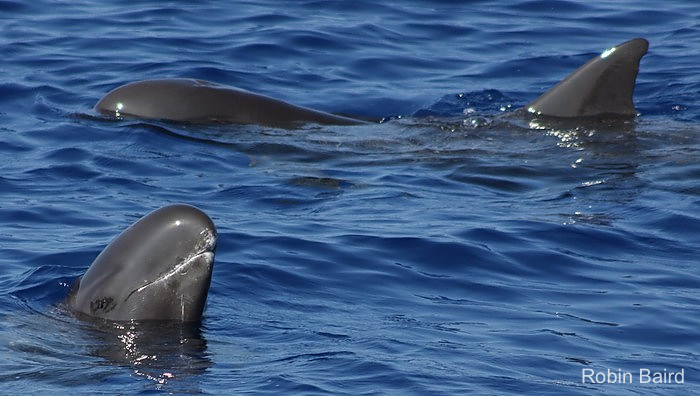
Two pygmy killer whales off Kona. Photo by Robin Baird. Although photo-identification evidence indicates that pygmy killer whales are resident to the area, we see this species only very infrequently – this sighting was only our 13th in nine years of working in Hawai’i. With such infrequent sightings learning anything about this poorly-known species is a slow process, but we have always prioritized efforts based on the inverse of sighting frequency – we spend the most time working with the least frequently-encountered species, to take advantage of these rare opportunities to learn more about such species. With this group of pygmy killer whales, we photo-identified every individual present (~12), made three acoustic recordings of the group, collected one biopsy sample for genetic, trophic ecology and pollutant analyses, and were able to deploy two satellite tags, the first satellite tags that have been deployed on this species. Nothing is known about movements of pygmy killer whales, so if these tags remain attached and functioning we will obtain the first movement information for this species.
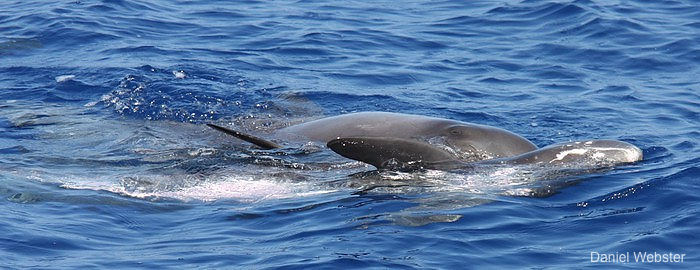
Two pygmy killer whales socializing. Photo by Daniel Webster. The rounded pectoral fin, characteristic of pygmy killer whales (and one way of discriminating them from melon-headed whales) is clearly visible.
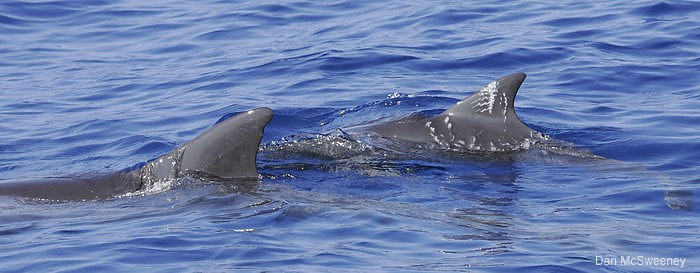
A pygmy killer whale calf with shark bite wounds. Photo by Dan McSweeney. The mother of this calf, HIFa009 in our catalog, has been documented on eight different occasions off Kona since 2003.
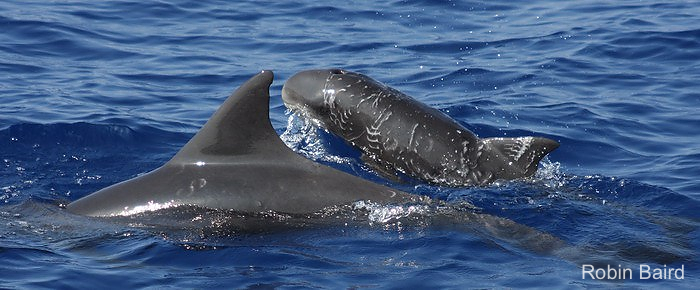
Another view of the pygmy killer whale calf with shark bite wounds. Photo by Robin Baird.
December 8, 2008 update
After eight days on the water we’ve now had 25 sightings of 10 different species of odontocetes, as well as one distant sighting of a humpback whale. Yesterday we re-located the group of pygmy killer whales seen the day before (including one of the two satellite tagged individuals) – they had moved just 30 kilometers in the almost 24 hours since tagging. As well as obtaining another acoustic recording of this group we were able to photo-identify all the individuals present.
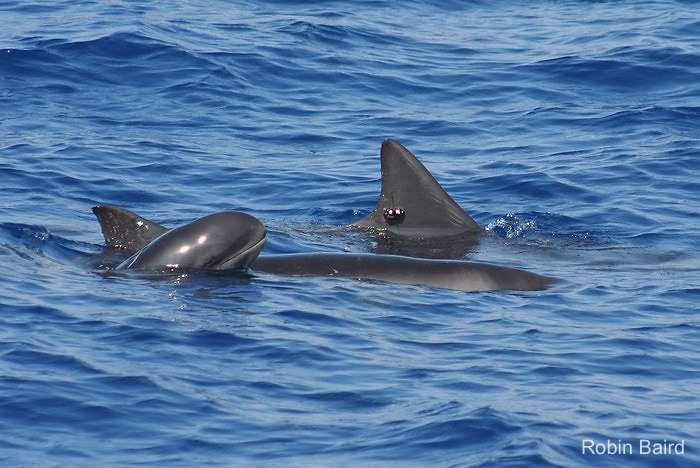
Satellite tagged pygmy killer whale with companions, December 7, 2008. Photo by Robin Baird.

Our 10th species of odontocete for this trip, a group of striped dolphins. Photo by Daniel Webster. This is our 20th sighting of striped dolphins from Hawaiian waters. This species is typically seen only in very deep water (usually >3,000 m), and almost always avoids boats. We frequently see them when surveying in waters >3,000 m so it is possible there is a resident population, but we have never been able to obtain biopsy samples for genetic analyses and few photographs that could be used to identify individuals to assess re-sightings.
December 10, 2008 update
On December 10th we recovered the High-frequency Acoustic Recording Package (HARP) deployed in July of this year. This system has been in place (in about 650 m of water) recording for five minutes out of every 15 minutes, and will be used by researcher Erin Oleson (of Scripps and the Pacific Islands Fisheries Science Center) to examine cetacean use of the area.
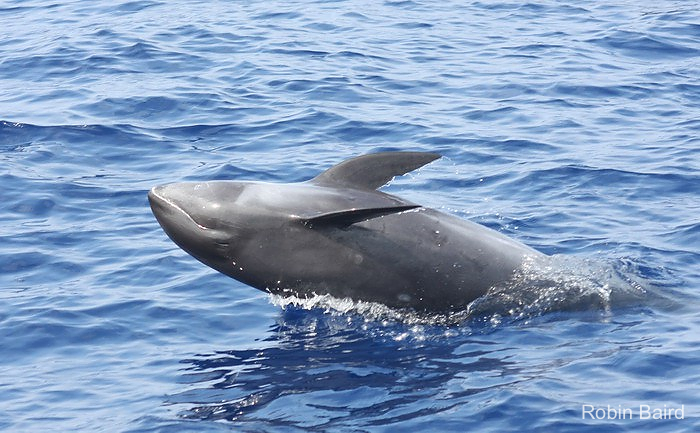
Leaping melon-headed whale, December 10, 2008. Photo by Robin Baird.
After 10 days on the water we’ve now encountered 12 species of odontocetes. December 10th was our longest day yet, covering over 170 kilometers of trackline and arriving back at the harbor half an hour after sunset. Sea conditions were very good to the north (an area often unworkable due to the trade winds) so we were able to survey more than 50 kilometers north of the harbor. At our furthest point north we encountered a group of over 300 melon-headed whales (the 11th species for the trip). This species is one of our favorites to work with – during the day they spend most of their time resting and socializing near the surface, are typically found in very large groups (the largest we’ve encountered was ~800 individuals), and they are extremely interested in boats (when we increase speed we can often attract 20 or 30 individuals over to bowride). Since so little is known about this species anywhere in the world the few encounters we have (this was our 31st encounter in nine years) have the potential to greatly increase our understanding of this species. During this encounter we collected 7 biopsy samples, primarily for toxicology but also for genetic analyses, ~2,700 photos for photo-identification (graduate student Jessica Aschettino at Hawai’i Pacific University is working on her Masters degree working with our melon-headed whale photo-identification catalog), deployed three satellite tags to examine movements, and made several recordings, in part for comparison with recordings obtained from the HARP.
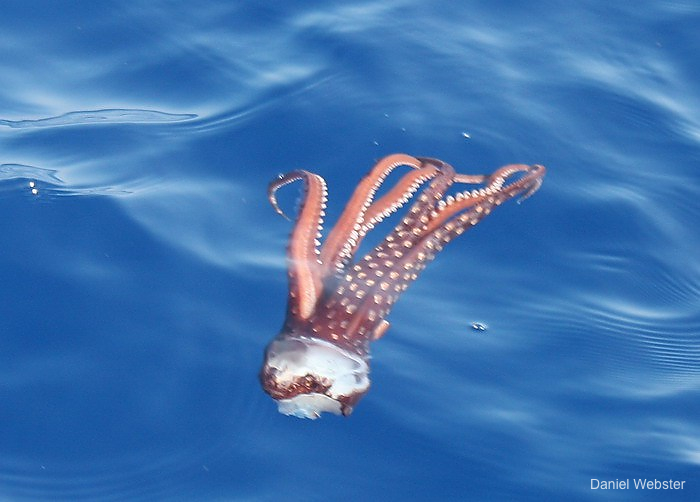
Floating squid collected December 10. Photo by Daniel Webster.
We also collected our fourth squid for the project, all to go to Bill Walker at NMML for species identification. Since many of the species we collect are not vertically migrating, they are likely brought up to the surface by foraging whales and accidentally left where we can sample them.
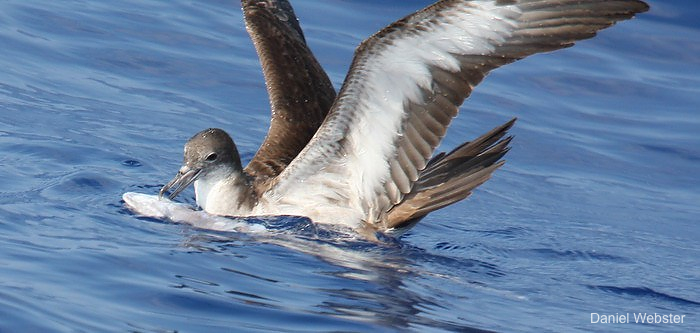
Wedge-tailed shearwater feeding on fish, found behind a group of pilot whales. Photo by Daniel Webster. Most of the squid (and fish) we collect are cued by birds feeding on them.
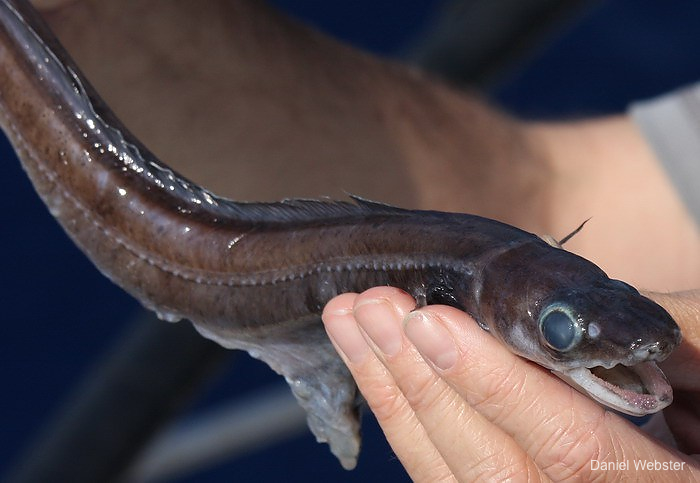
Fish (probably a codling) found behind a group of pilot whales. Photo by Daniel Webster. Based on the body shape and large eye this is likely a benthopelagic species.
Sixteen kilometers after we left the first group of melon-headed whales, we encountered a second group, this one containing over 500 individuals. Due to time constraints we only obtained ~700 photos of individuals in this group, but made another recording and obtained an additional five biopsy samples. Still 17 km from the harbor and only an hour before sunset we encountered our 12th species of odontocete for the trip, a group of false killer whales.
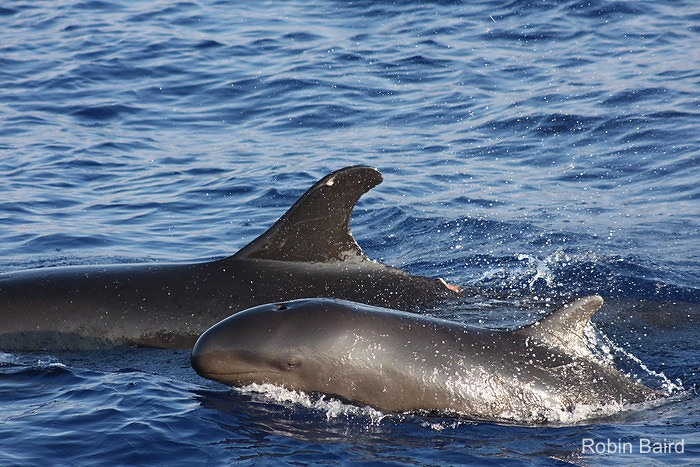
Mother and calf false killer whale, December 10, 2008. Photo by Robin Baird. Unfortunately this group was traveling rapidly north (away from the harbor), and we had to get back to drop off one of our crew at the airport for a flight back to the mainland, but we did have time to obtain ID photos of at least six of the nine individuals seen, and also deployed a satellite tag on one individual to examine movements. A long day on the water.
December 11, 2008 update
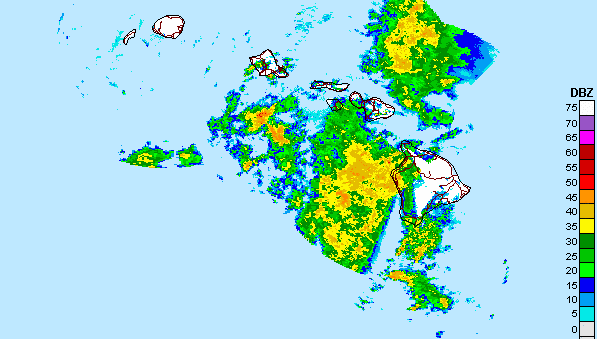
We are on land today as a storm passes through. Radar image from http://radar.weather.gov/Conus/hawaii.php
December 14, 2008 update
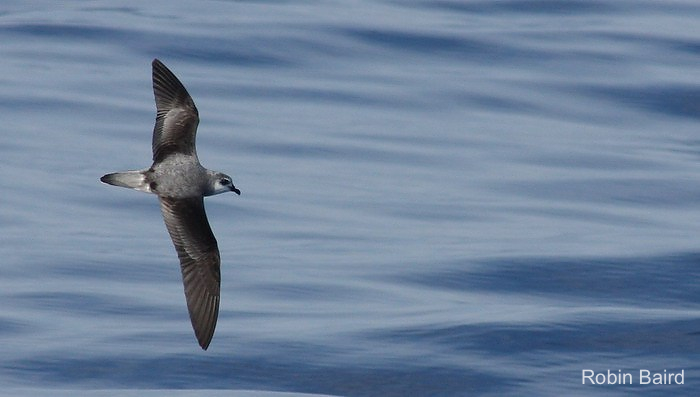
A black-winged petrel, December 13, 2008. Photo by Robin Baird.
Our second encounter with beaked whales this trip, this time two adult Cuvier’s beaked whales seen December 13, 2008. We were able to obtain identification photographs of both individuals, and both match to individuals already in our catalog.
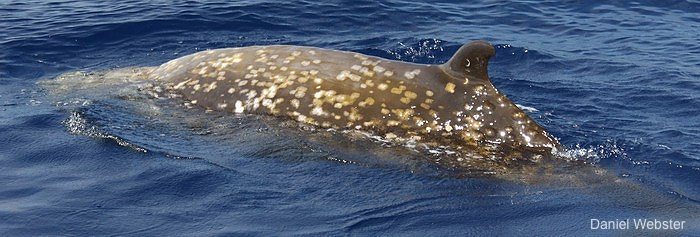
An adult female Cuvier’s beaked whale, December 13, 2008. Photo by Daniel Webster. This individual, HIZc050 in our catalog, has been documented twice previously, in December 2006 and October 2008. The white oval scars on this individual are caused by cookie-cutter sharks – these scars are the primary cues we use for identifying individual beaked whales – similar scars (and notches on the dorsal fin) are used to identify other species of whales. Such markings (albeit not caused by cookie-cutter sharks) can be used to identify many terrestrial mammals as well, including, we suspect, Uinta ground squirrels in Bozeman, Montana.
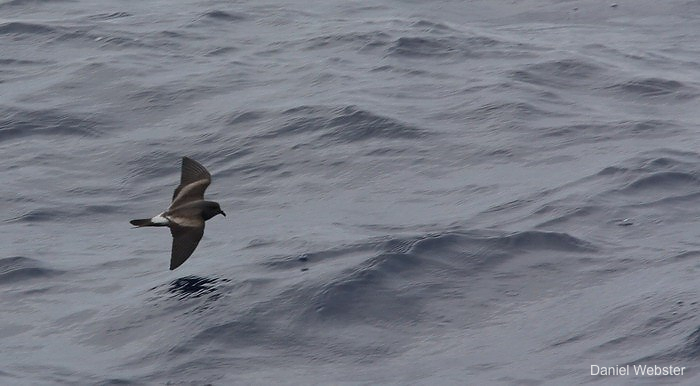
December 14th was a good day for birds (and we saw one group of ~40 pilot whales). We had our first storm petrel sightings of the trip (three Leach’s storm petrels, photo by Daniel Webster), and approximately 16 other “gadfly” petrels, including a number of black-winged petrels and a possible white-necked petrel. Also seen were four sooty shearwaters, one female greater frigatebird, and about 24 wedge-tailed shearwaters.
Final update
December 16 was our last day on the water. We were on the water 14 of the last 16 days, and had 41 sightings of 12 species of odontocetes. On December 15 we re-deployed the HARP – this will be in place until February (recording continuously), when it will be recovered and re-deployed by Erin Oleson.
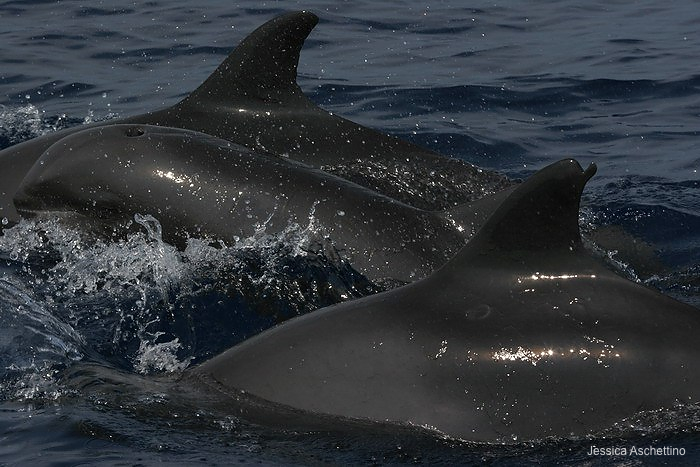
Melon-headed whales, December 15. Photo by Jessica Aschettino.
We had our best sighting day on the 15th, with seven encounters of six different species of odontocetes. Along with bottlenose, spotted, spinner and rough-toothed dolphins, we encountered short-finned pilot whales and another group of melon-headed whales (different from the group we deployed satellite tags on the previous week), and deployed one additional satellite tag on a melon-headed whale.
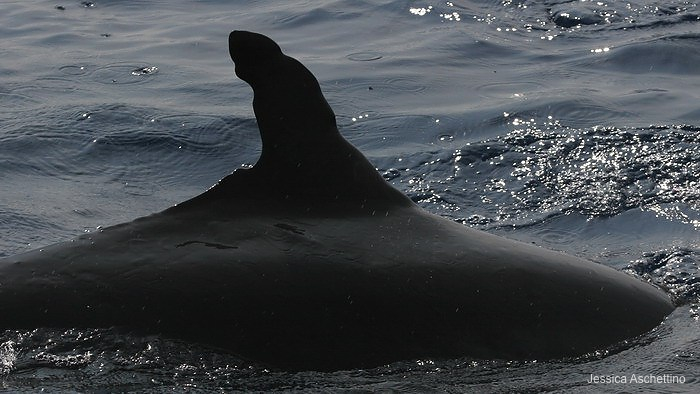
An extremely distinctive melon-headed whale. Photo by Jessica Aschettino.
As of the 16th we have satellite tags out on three species off the island, one false killer whale, four melon-headed whales (in two different groups), and one pygmy killer whale – all have remained associated with the island since tagging, and we will be watching movements of these individuals hopefully over the 6 to 10 weeks. We were able to make good acoustic recordings of both pygmy killer whales and melon-headed whales, which will be extremely valuable in assessing the presence of both species in previous (and future) recordings from the HARP. We collected 40 genetic samples (several were sloughed skin), many of which will also be used for toxicology. We also collected four squid, one fish, and part of an another fish, the latter left behind by a group of rough-toothed dolphins, for assessing prey. We also took ~14,500 photographs, primarily for individual photo-identification, which will be used to continue to examine movements and site fidelity of the species encountered.
Our next trip to Hawai‘i should be in April 2008, check back then for future updates.
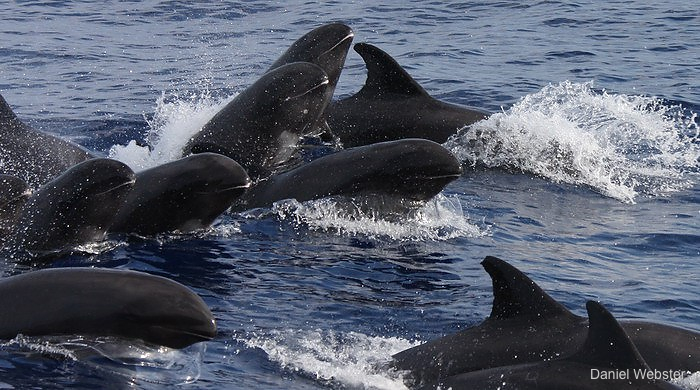
Melon-headed whales. Photo by Daniel Webster.
Thanks to Peter Pyle, Mike Ord and Pete Donaldson for providing information on bird species seen.
All photos on this page taken under NMFS Scientific Research Permits (Nos. 731-1774 and 774-1714). All photos are copyrighted and should not be used without permission.